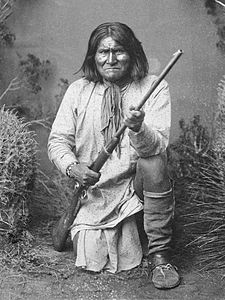
Geronimo (Chiricahua: Goyaałé, "one who yawns"; often spelled Goyathlay or Goyahkla[1] in English) (June 16, 1829–February 17, 1909) was a prominent Native American leader of the Chiricahua Apache who fought against Mexico and the United States and their expansion into Apache tribal lands for several decades.
Biography
Goyathlay (Geronimo) was born to the Bedonkohe band of the Apache, near Turkey Creek,[2] a tributary of the Gila River in the modern-day state of Arizona,[3] then part of Mexico, but which his family considered Bedonkohe land. He had three brothers and four sisters.
Geronimo's father, Tablishim, and mother, Juana, educated him according to Apache traditions. He married a woman from the Chiricahua band of Apache when he was 17; they had three children. On March 5, 1851, a company of 400 Mexican soldiers from Sonora led by Colonel José María Carrasco attacked Geronimo's camp outside Janos while the men were in town trading. Among those killed were Geronimo's wife, Alope, his children, and his mother. His chief, Mangas Coloradas, sent him to Cochise's band for help in revenge against the Mexicans. It was the Mexicans who named him Geronimo. This appellation stemmed from a battle in which he repeatedly attacked Mexican soldiers with a knife, ignoring a deadly hail of bullets, in reference to the Mexicans' plea to Saint Jerome ("Jeronimo!"). The name stuck.[1]
The first Apache raids on Sonora appear to have taken place during the late 17th century. To counter the early Apache raids on Spanish settlements, presidios were established at Janos (1685) in Chihuahua and at Fronteras (1690) in northern Opata country. In 1835, Mexico had placed a bounty on Apache scalps. Two years later Mangas Coloradas or Dasoda-hae (Red Sleeves) became principal chief and war leader and began a series of retaliatory raids against the Mexicans. Apache raids on Mexican villages were so numerous and brutal that no area was safe.[4]
While Geronimo said he was never a chief, he was a military leader. As a Chiricahua Apache, this meant he was also a spiritual leader ( war shaman ) who was recognized for holding and using specific supernatural "powers". Among these were the ability to walk without leaving tracks; the abilities now known as telekinesis and telepathy; and the ability to survive gunshot ( rifle/musket, pistol, and shotgun ). Geronimo was wounded numerous times by both bullets and buckshot, but survived. Warriors who followed him offered first-hand eye-witness testamony regarding his many "powers" while on the warpath and declared that this was the main reason why so many chose to follow him ( he was favored by/protected by, "Usen", the Apache high-god). Geronimo's "powers" were considered to be so great that he personally painted the faces of the warriors who followed him to reflect their protective capactities. The well-known white stripe across the face and over the nose, and the red dot or circle on the forehead were Geronimo's personal war paint pattern which can be seen on some of his warriors in the photos taken of them before their last surrender. During his career as a war leader, Geronimo was notorious for consistently urging raids and war upon Mexican Provinces and their various towns, and later against American locations across Arizona, New Mexico, and western Texas.[5]
He married Chee-hash-kish and had two children, Chappo and Dohn-say. Then he took another wife, Nana-tha-thtith, with whom he had one child. He later had a wife named Zi-yeh at the same time as another wife, She-gha, one named Shtsha-she and later a wife named Ih-tedda. Some of his wives were captured, such as the young Ih-tedda. Wives came and went, overlapping each other, being captured and added to the family, lost, or even given up, as Geronimo did with Ih-tedda when he and his band surrendered. At that time he kept his wife She-gha but abandoned the younger wife, Ih-tedda. Geronimo's last wife was Azul.
Though outnumbered, Geronimo fought against both Mexican and United States troops and became famous for his daring exploits and numerous escapes from capture from 1858 to 1886. One such escape, as legend has it, took place in the Robledo Mountains of southwest New Mexico. The legend states Geronimo and his followers entered a cave, and the U.S. Soldiers waited outside the cave entrance for him, but he never came out. Later it was heard that Geronimo was spotted in a nearby area. The second entrance to the cave has yet to be found and the cave is still called Geronimo's Cave. At the end of his military career, he led a small band of 36 men, women, and children. They evaded 5,000 U.S. troops (a quarter of the army at the time)[citation needed] and many units of the Mexican army for a year. His band was one of the last major forces of independent Indian warriors who refused to acknowledge the United States Government in the American West.
Pursuit and capture
In 1886, General Nelson A. Miles selected Captain Henry Lawton, in command of B Troop, 4th Cavalry, at Ft. Huachuca to lead the expedition that captured Geronimo. Numerous stories abound as to who actually captured Geronimo, or to whom he surrendered. For Lawton's part, he was given orders to head up actions south of the U.S.–Mexico boundary where it was thought Geronimo and a small band of his followers would take refuge from U.S. authorities. Lawton was to pursue, subdue, and return Geronimo to the U.S., dead or alive.
Lawton's official report dated September 9, 1886 sums up the actions of his unit and gives credit to a number of his troopers for their efforts. Geronimo gave credit to Lawton's tenacity for wearing the Apaches down with constant pursuit. Geronimo and his followers had little or no time to rest or stay in one place. Completely worn out, the little band of Apaches returned to the U.S. with Lawton and officially surrendered to General Miles on September 4, 1886 at Skeleton Canyon, Arizona. While the debate over who Geronimo surrendered to goes on, it should be remembered that Native Americans rarely 'surrendered' to junior officers. They surrendered to General officers or higher.[citation needed]
Geronimo and other warriors were sent as prisoners to Fort Pickens, Florida, and his family was sent to Fort Marion. They were reunited in May 1887, when they were transferred to Mount Vernon Barracks in Alabama for five years. In 1894, they were moved to Fort Sill, Oklahoma. In his old age, Geronimo became a celebrity. He appeared at fairs, including the 1904 World's Fair in St. Louis, and sold souvenirs and photographs of himself. However, he was not allowed to return to the land of his birth. He also rode in President Theodore Roosevelt's 1905 inaugural parade.
In 1905, Geronimo agreed to tell his story to S.M. Barrett, Superintendent of Education in Lawton, Oklahoma. Barrett had to appeal to President Roosevelt to gain permission to publish the book. Geronimo came to each interview knowing exactly what he wanted to say. He refused to answer questions or alter his narrative. Barrett did not seem to take many liberties with Geronimo's story as translated by Asa Daklugie. Frederick Turner re-edited this autobiography by removing some of Barrett's footnotes and writing an introduction for the non-Apache readers. Turner notes the book is in the style of an Apache reciting part of his oral history.[6]
Geronimo died of pneumonia on February 17, 1909 at Fort Sill, Oklahoma, and was buried at the Apache Indian Prisoner of War Cemetery there.

Religion
Geronimo was raised with the traditional religious views of the Bedonkohe. When questioned about his views on life after death, he wrote in his 1905 autobiography, "As to the future state, the teachings of our tribe were not specific, that is, we had no definite idea of our relations and surroundings in after life. We believed that there is a life after this one, but no one ever told me as to what part of man lived after death...We held that the discharge of one's duty would make his future life more pleasant, but whether that future life was worse than this life or better, we did not know, and no one was able to tell us. We hoped that in the future life family and tribal relations would be resumed. In a way we believed this, but we did not know it." [7]
Later in life, Geronimo embraced Christianity, and stated, "Since my life as a prisoner has begun I have heard the teachings of the white man's religion, and in many respects believe it to be better than the religion of my fathers...Believing that in a wise way it is good to go to church, and that associating with Christians would improve my character, I have adopted the Christian religion. I believe that the church has helped me much during the short time I have been a member. I am not ashamed to be a Christian, and I am glad to know that the President of the United States is a Christian, for without the help of the Almighty I do not think he could rightly judge in ruling so many people. I have advised all of my people who are not Christians, to study that religion, because it seems to me the best religion in enabling one to live right." [8]He joined the Dutch Reformed Church in 1903 but four years later was expelled for gambling.[9] To the end of his life, he seemed to harbor ambivalent religious feelings, telling the Christian missionaries at a summer camp meeting in 1908 that he wanted to start over, while at the same time telling his tribesmen that he held to the old Apache religion.[10]
Theft of remains
In 1918, certain remains of Geronimo were stolen in a grave robbery. Three members of the Yale secret society of Skull and Bones served as Army volunteers at Fort Sill during World War I; one of those three members was Prescott Bush, father of the forty-first President of the United States George H. W. Bush and grandfather of George W. Bush. They reportedly stole Geronimo's skull, some bones, and other items, including Geronimo's prized silver bridle, from the Apache Indian Prisoner of War Cemetery. The stolen items were alleged to have been taken to the society's tomb-like headquarters on the Yale University campus, and are supposedly used in rituals practiced by the group, one of which is said to be kissing the skull of Geronimo as an initiation. The story was known for many years but widely considered unlikely or apocryphal, and while the society itself remained silent, former members have said that they believed the bones were fake or non-human, possibly in an attempt at misdirection.[original research?]
In a contemporary letter discovered by the Yale historian Marc Wortman and published in the Yale Alumni Magazine in 2006, society member Winter Mead wrote to F. Trubee Davison:
The skull of the worthy Geronimo the Terrible, exhumed from its tomb at Fort Sill by your club... is now safe inside the tomb ("tomb" is the building at Yale University's Skull and Bones) and bone together with his well worn femurs, bit and saddle horn.[11]
This prompted the Indian chief's great-grandson, Harlyn Geronimo of Mescalero, New Mexico, to write to President Bush requesting his help in returning the remains:
According to our traditions the remains of this sort, especially in this state when the grave was desecrated ... need to be reburied with the proper rituals ... to return the dignity and let his spirits rest in peace.[12]
Popular culture
- The 501st Parachute Infantry Regiment's motto and slogan was named after him. In 1940, the night before their first mass jump, U.S. paratroopers at Fort Benning watched the 1939 film Geronimo, in which the actor playing Geronimo yells his name as he leaps from a high cliff into a river, depicting a real-life escape Geronimo successfully attempted in which he jumped off Medicine Bluff at Fort Sill, Oklahoma, into the Medicine Creek with his Cadillac horse. Private Aubrey Eberhardt announced he would shout the name when he jumped from the airplane to prove he was not scared. The trend has since caught on elsewhere, becoming widely associated with any sort of high jump in popular culture. This unit was the first parachute battalion of the United States Army.[13][14]
- In 1943, a U.S. Liberty ship named the SS Geronimo was launched. It was scrapped in 1960.
- Three towns in the United States are named for him: one in Arizona, one in Oklahoma, and another in Texas.
Movies & television

Geronimo is a popular figure in cinema and television. Characters based on Geronimo have appeared in many films, including:
- Geronimo's Last Raid (1912)
- Hawk of the Wilderness (1938)
- Geronimo (1939)
- Stagecoach (1939)
- Valley of the Sun (1942)
- Fort Apache (1948)
- Broken Arrow (1950)
- I Killed Geronimo (1950)
- Outpost (1951)
- Son of Geronimo (1952)
- The Battle at Apache Pass (1952)
- Indian Uprising (1952)
- Apache (1954)
- Taza, Son of Cochise (1954)
- Walk the Proud Land (1956)
- Geronimo (1962)
- Geronimo und die Räuber (West German, 1966)
- I Due superpiedi quasi piatti (1976)
- Mr. Horn (1979)
- Geronimo: A Thought-Provoking Look Into the Gang Lifestyle (Starring Paul Jeans) (1990)
- Gunsmoke: The Last Apache (1990)
- Geronimo (Starring Joseph Runningfox) (1993)
- Geronimo: An American Legend (1993)
- Hot Shots! Part Deux (1993)
- Geronimo (1993)
- War of the Buttons (1994)

Source: Wikipedia



No comments:
Post a Comment